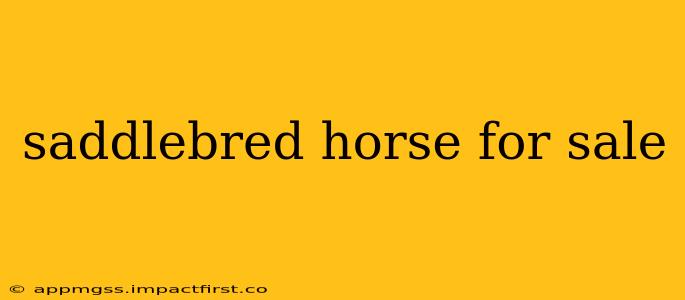Finding the right Saddlebred horse for sale can be an exciting but potentially overwhelming journey. These elegant and versatile horses, known for their high-stepping gait and graceful movements, are prized by riders of all levels. This comprehensive guide will help you navigate the process, from understanding different types of Saddlebreds to asking the right questions before making a purchase.
What Types of Saddlebred Horses Are For Sale?
Saddlebreds aren't a one-size-fits-all breed. Understanding the different types will help you narrow your search and find a horse that matches your riding style and experience level.
-
Three-Gaited Saddlebreds: These horses perform three distinct gaits: walk, trot, and canter. They're often chosen by riders who appreciate a smooth, comfortable ride and are perfect for pleasure riding or showing in certain disciplines.
-
Five-Gaited Saddlebreds: These horses showcase five gaits: walk, trot, canter, slow gait, and rack. The slow gait and rack are unique, distinctive gaits that require significant training and skill to execute properly. These horses are often seen in higher-level competition.
-
American Saddlebreds: This is the overarching term for the breed, encompassing both three- and five-gaited horses. When searching for a horse for sale, you'll encounter both terms.
-
Park Saddlebreds: Within the American Saddlebred breed, Park horses are known for their flashy, high-stepping gaits and showmanship. They emphasize style and presentation in the show ring.
What Should I Look For When Buying a Saddlebred Horse?
Finding the perfect Saddlebred requires careful consideration. Here's a checklist to guide you:
-
Age and Experience: Consider your riding experience and choose a horse whose age and training level match your abilities. A younger horse will require more training and patience, while an older, more experienced horse might be a better fit for a less experienced rider.
-
Conformation: Evaluate the horse's physical structure. Look for a well-balanced build with strong legs, sound hooves, and a correct conformation that suggests soundness and longevity.
-
Temperament: A calm, well-mannered temperament is essential, especially for beginners. Observe the horse's behavior around people and other horses. A good temperament will make your riding experience more enjoyable and safe.
-
Training: Inquire about the horse's training history, including past riding experiences and any known vices. Understanding its training level will allow you to assess if it's suitable for your abilities and goals.
-
Health Records: Request thorough veterinary records, including vaccination history, dental records, and any past illnesses or injuries. This is crucial to ensure the horse's overall health and wellbeing.
Where Can I Find Saddlebred Horses for Sale?
Several avenues exist to find Saddlebreds for sale:
-
Online Marketplaces: Numerous websites specialize in listing horses for sale, offering a wide selection of Saddlebreds across various locations and price ranges. Be sure to thoroughly research any seller before making a commitment.
-
Breed Associations: National and regional Saddlebred associations often have listings or can connect you with breeders and sellers in your area.
-
Local Dealers and Trainers: Contact local horse dealers and trainers in your area. They may have Saddlebreds for sale or know of horses that are available.
-
Word of Mouth: Network within the equestrian community. Talk to other riders, trainers, and breeders. Word-of-mouth referrals can be a valuable resource.
How Much Does a Saddlebred Horse Cost?
The price of a Saddlebred horse can vary widely depending on several factors: age, training level, pedigree, and conformation. Expect to pay a range from several thousand dollars for a younger, less-trained horse to tens of thousands for a highly trained show horse with an established pedigree.
What are the Common Health Issues in Saddlebred Horses?
Like all breeds, Saddlebreds are susceptible to certain health issues. Common concerns include:
-
Equine Metabolic Syndrome (EMS): A condition characterized by insulin resistance, obesity, and laminitis.
-
Laminitis: An inflammation of the sensitive laminae in the hoof.
-
Osteoarthritis: A degenerative joint disease that can affect horses of any age.
Thorough veterinary examination before purchase is essential to mitigate potential health concerns.
How Can I Prepare for Owning a Saddlebred Horse?
Owning a horse is a significant commitment. Before purchasing, consider the following:
-
Financial Resources: Factor in not only the purchase price but also ongoing costs such as feed, farrier, vet care, boarding, and equipment.
-
Facilities: Ensure you have appropriate facilities to house and care for a horse, including a suitable stable or paddock.
-
Time Commitment: Horses require daily care and attention. Assess if you have the time to dedicate to their needs.
By carefully considering these factors and conducting thorough research, you'll increase your chances of finding the perfect Saddlebred horse to share your passion for riding. Remember, patience and careful consideration are key to finding a healthy, happy, and suitable partner for years to come.
